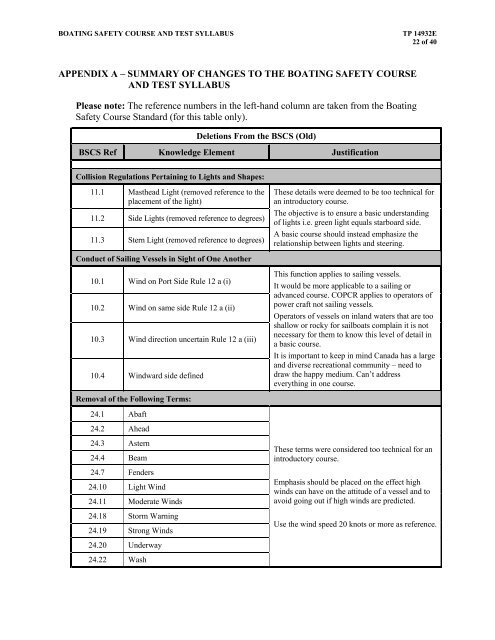Boating Safety Course and Test Syllabus - Transport Canada
Boating Safety Course and Test Syllabus - Transport Canada
Boating Safety Course and Test Syllabus - Transport Canada
Create successful ePaper yourself
Turn your PDF publications into a flip-book with our unique Google optimized e-Paper software.
BOATING SAFETY COURSE AND TEST SYLLABUS TP 14932E<br />
22 of 40<br />
APPENDIX A – SUMMARY OF CHANGES TO THE BOATING SAFETY COURSE<br />
AND TEST SYLLABUS<br />
Please note: The reference numbers in the left-h<strong>and</strong> column are taken from the <strong>Boating</strong><br />
<strong>Safety</strong> <strong>Course</strong> St<strong>and</strong>ard (for this table only).<br />
Deletions From the BSCS (Old)<br />
BSCS Ref Knowledge Element Justification<br />
Collision Regulations Pertaining to Lights <strong>and</strong> Shapes:<br />
11.1 Masthead Light (removed reference to the<br />
placement of the light)<br />
11.2 Side Lights (removed reference to degrees)<br />
11.3 Stern Light (removed reference to degrees)<br />
Conduct of Sailing Vessels in Sight of One Another<br />
10.1 Wind on Port Side Rule 12 a (i)<br />
10.2 Wind on same side Rule 12 a (ii)<br />
10.3 Wind direction uncertain Rule 12 a (iii)<br />
10.4 Windward side defined<br />
Removal of the Following Terms:<br />
24.1 Abaft<br />
24.2 Ahead<br />
24.3 Astern<br />
24.4 Beam<br />
24.7 Fenders<br />
24.10 Light Wind<br />
24.11 Moderate Winds<br />
24.18 Storm Warning<br />
24.19 Strong Winds<br />
24.20 Underway<br />
24.22 Wash<br />
These details were deemed to be too technical for<br />
an introductory course.<br />
The objective is to ensure a basic underst<strong>and</strong>ing<br />
of lights i.e. green light equals starboard side.<br />
A basic course should instead emphasize the<br />
relationship between lights <strong>and</strong> steering.<br />
This function applies to sailing vessels.<br />
It would be more applicable to a sailing or<br />
advanced course. COPCR applies to operators of<br />
power craft not sailing vessels.<br />
Operators of vessels on inl<strong>and</strong> waters that are too<br />
shallow or rocky for sailboats complain it is not<br />
necessary for them to know this level of detail in<br />
a basic course.<br />
It is important to keep in mind <strong>Canada</strong> has a large<br />
<strong>and</strong> diverse recreational community – need to<br />
draw the happy medium. Can’t address<br />
everything in one course.<br />
These terms were considered too technical for an<br />
introductory course.<br />
Emphasis should be placed on the effect high<br />
winds can have on the attitude of a vessel <strong>and</strong> to<br />
avoid going out if high winds are predicted.<br />
Use the wind speed 20 knots or more as reference.

















